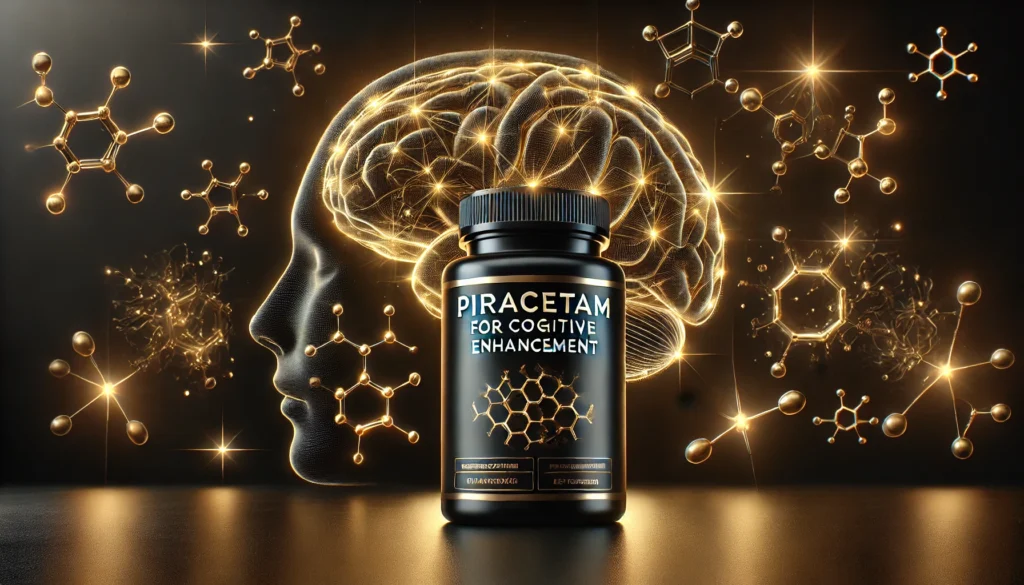When initially discovered, piracetam piqued the curiosity of both scientists and those looking to improve their cognitive function. It has been extensively investigated whether this synthetic substance, generated from gamma-aminobutyric acid (GABA), might enhance alertness, focus, and cognition. This article provides a comprehensive overview of piracetam’s chemistry, health advantages, recommended dosage, adverse effects, potential drug interactions, and responsible use.
You May Also Like:
Modafinil: Benefits, Dosage, Side Effects, Drug Interactions, And Other Important Information
Theaflavin: Benefits, Dosage, Side Effects, Drug Interactions, and Other Important Information
Nature of Piracetam
Piracetam is a synthetic substance produced in a lab rather than through natural chemical processes. It was the first nootropic substance to be found, paving the path for the creation of other synthetic chemicals that enhance cognitive function. Although synthetic, piracetam has a low incidence of adverse effects and a generally safe profile when used sensibly and with a healthcare provider’s supervision.
Discover the Science of Better Sleep with Expertly Formulated Supplements—Buy Now on Amazon!
Health Benefits of Piracetam
The possible health advantages of piracetam in various groups have been the subject of numerous research. The most encouraging results include the following:
- Cognitive Enhancement: Studies have shown that piracetam can help people with healthy and cognitively impaired cognitive abilities, including memory, learning, and attention. However, the degree of improvement varies between studies; and some have found only minor or insignificant improvements. The variance may be related to demographic testing, dosage, and study methodology variations.
- Alzheimer’s disease and dementia: Piracetam has been demonstrated to reduce some cognitive symptoms in people with Alzheimer’s disease and other types of dementia, even though it is not a cure. Moreover, it might halt the trajectory of these patients’ cognitive impairment.
- Dyslexia: According to certain research, piracetam can help dyslexic children and teenagers with reading and writing skills. The effects could be due to piracetam’s impact on synaptic plasticity and neural transmission.
- Research suggests that piracetam may aid those who have suffered traumatic brain injury or stroke in their quest to regain cognitive function. Piracetam’s capacity to increase cerebral blood flow, encourage neuronal regeneration, and modify neurotransmitter release may cause the reported cognitive gains.

Chemistry of Piracetam
Piracetam, also known as 2-oxo-1-pyrrolidine acetamide, is a member of the racetam class of nootropics. Although it does not directly affect GABAergic neurotransmission, it is a cyclic derivative of GABA. The pyrrolidone nucleus in the chemical makeup of piracetam gives it its nootropic effects. While having a GABA origin, piracetam works differently than GABAergic modulation to produce its effects.
Physiological Mechanism of Action
The precise processes underlying the cognitive-improving effects of piracetam are not well understood. Nonetheless, several theories have been put out, some of them are as follows:
- Piracetam is thought to interact with the lipid bilayer of neuronal cell membranes to increase their fluidity, which leads to the first effect. The function of membrane-bound proteins like receptors and ion channels is consequently improved by this increased fluidity, which also increases membrane permeability. As a result, synaptic plasticity and neural communication—both of which are important for learning and memory processes—are enhanced.
- Neurotransmitter Release: Acetylcholine, a neurotransmitter essential for cognitive processes like memory formation, attention, and learning, has been demonstrated to be released more readily when piracetam is taken. Piracetam’s association with presynaptic receptor sites and augmentation of calcium influx, which encourages neurotransmitter release, are likely mediating factors for this effect.
- Cerebral Blood Flow: Research has shown that piracetam can boost cerebral blood flow and the brain’s use of oxygen. This result may contribute to its cognitive-improving qualities by giving the brain the nutrition and oxygen it needs to perform at its best.
- Regulation of the glutamate receptor: Piracetam, notably through its interaction with the AMPA receptor, may affect glutamatergic neurotransmission. This receptor is essential for cognitive functions and synaptic plasticity. By modifying AMPA receptor function, piracetam may improve long-term potentiation, a crucial mechanism for learning and memory.

Optimal Dosage of Piracetam
Due to the wide range of individual responses and the precise cognitive goals intended, figuring out the best piracetam dosage might be difficult. Piracetam dosages typically range between 1,200 and 4,800 mg daily, split into two or three doses. According to some research, healthy persons may benefit from a daily dose of 2,400 mg. However, patients with cognitive impairments or specific illnesses like Alzheimer’s disease may require greater doses.
Remembering that the ideal dosage may differ depending on a person’s age, weight, and underlying medical conditions is crucial. Before beginning piracetam use, like with any supplement, it is imperative to speak with a medical practitioner.
Side Effects of Piracetam
Piracetam generally has a low frequency of side effects and is well tolerated. Nonetheless, some people may have modest adverse responses, such as:
- Headaches: One of the most often seen side effects of piracetam use is headaches. They are believed to be caused by increased cholinergic activity and are frequently relieved by taking a choline source supplement, like alpha-GPC or citicoline.
- Digestive Problems: Some users may encounter minor and temporary gastrointestinal problems, such as nausea, diarrhea, or stomach cramps.
- In rare instances, piracetam may cause anxiety or insomnia. Usually dose-dependent, these adverse effects can be lessened or avoided by reducing piracetam use.
- Allergic Reactions: Although rare, some people may experience allergic or hypersensitive reactions to piracetam. These reactions might show up as skin rashes, itching, or swelling. If these signs appear, stop using the medication and seek medical advice.

Potential Substance Interactions with Piracetam
The likelihood of piracetam interfering with other medications is relatively low. Yet some interactions need to be taken into account:
- Anticoagulants: When taken at the same time as anticoagulant drugs like warfarin or heparin, piracetam may raise the risk of bleeding. Before mixing piracetam with these drugs, seek medical advice.
- Cholinergic Agents: Piracetam may enhance the effects of other cholinergic agents, such as acetylcholinesterase inhibitors or choline supplements, resulting in excessive cholinergic activity. When used with piracetam, these medications should have their dosages adjusted appropriately.
- Alcohol: Piracetam may have additive or unforeseen effects on cognitive performance when used with alcohol. When using piracetam, it is best to avoid or consume alcohol in moderation.

Best Responsible Uses of Piracetam
Although piracetam has been shown to have cognitive-enhancing effects, it is essential to utilize it responsibly:
- Speak with a Medical Professional: Before beginning piracetam therapy, consult a medical expert to identify the correct dosage and weigh any dangers or contraindications.
- Start with a Low Dose: The piracetam dose should be started at a low level and increased gradually based on each person’s response and tolerance.
- Watch for any side effects or bad reactions, and alter the dosage or stop using the product as needed.
- Don’t Depend Just on Piracetam: Piracetam cannot replace a healthy lifestyle, a balanced diet, or enough sleep. Piracetam should be used as an adjunct to other research-proven techniques for cognitive enhancement, such as consistent exercise, a healthy diet, and sound sleeping habits.
- Use with Care in Vulnerable Populations: Even though piracetam has demonstrated potential advantages several vulnerable populations, including those with Alzheimer’s disease, dyslexia, or brain injuries, it is crucial to use caution and speak with a healthcare provider before using it. Those using drugs or those who have pre-existing medical issues should exercise extra caution.
Piracetam: Conclusion
Piracetam is a promising nootropic supplement that supports cognitive enhancement, neuroprotection, improved brain circulation, stroke recovery, mood stabilization, and enhanced sensory perception. Its diverse benefits make it an intriguing option for those seeking to improve mental function and overall brain health. Despite these potential benefits, the use of piracetam should be approached with caution. It is important to consult with a healthcare professional before starting supplementation, especially for individuals with underlying health conditions or those taking other medications, to ensure safety and appropriate dosing.

References:
- The “nootropic” approach to the pharmacology of the integrative activity of the brain. Retrieved from: https://pubmed.ncbi.nlm.nih.gov/4736348/
- Piracetam: A Review of Pharmacological Properties and Clinical Uses. Retrieved from: https://onlinelibrary.wiley.com/doi/abs/10.1111/j.1527-3458.2005.tb00268.x
- Piracetam and Piracetam-Like Drugs: From Basic Science to Novel Clinical Applications to CNS Disorders. Retrieved from: https://link.springer.com/article/10.2165%2F11319230-000000000-00000
- Piracetam and other structurally related nootropics. Retrieved from: https://pubmed.ncbi.nlm.nih.gov/8061686/
Important Note: The information contained in this article is for general informational purposes only, and should not be construed as health or medical advice, nor is it intended to diagnose, prevent, treat, or cure any disease or health condition. Before embarking on any diet, fitness regimen, or program of nutritional supplementation, it is advisable to consult your healthcare professional in order to determine its safety and probable efficacy in terms of your individual state of health.
Regarding Nutritional Supplements Or Other Non-Prescription Health Products: If any nutritional supplements or other non-prescription health products are mentioned in the foregoing article, any claims or statements made about them have not been evaluated by the U.S. Food and Drug Administration, and such nutritional supplements or other health products are not intended to diagnose, treat, cure, or prevent any disease.


